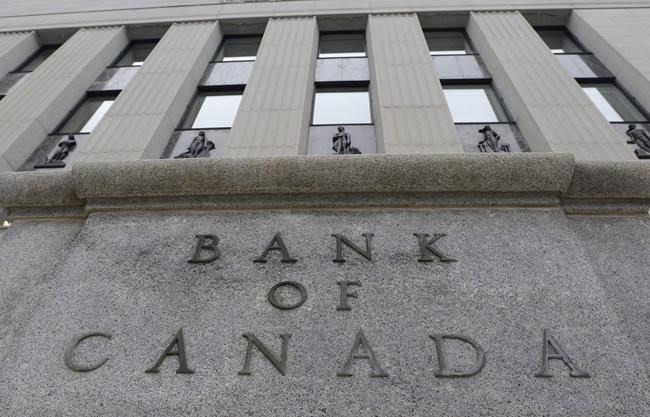
The Bank of Canada is seen Wednesday September 6, 2017 in Ottawa.The Bank of Canada keeps its key interest rate target on hold at 1.25 per cent. THE CANADIAN PRESS/Adrian Wyld
Republished March 07, 2018 - 11:43 AM
Original Publication Date March 07, 2018 - 7:06 AM
OTTAWA - A cautious Bank of Canada kept its key interest rate on hold Wednesday as it bought itself more time to monitor mounting trade-related uncertainties out of the United States.
In sticking with its 1.25 per cent overnight target, the central bank blamed recent trade policy changes for the thickening clouds around the economic outlook.
Last week, U.S. President Donald Trump threatened to impose heavy tariffs on Canadian steel and aluminum. The announcement added to an already murky context for Canada that includes concerns over NAFTA's renegotiation and fears over competitiveness, following corporate tax cuts south of the border.
The prospect of tariffs has created deep concerns in Canada, the No. 1 supplier of both steel and aluminum to the U.S. Ottawa has hinted at retaliatory action, as have the European Union and Mexico, in what could become an all-out trade war.
Trump has said that Canada and Mexico might be spared from his plans for a 25 per cent tariff on steel imports and 10 per cent tariff on aluminum imports if they agree to better terms for the U.S. in talks aimed at revising the North American Free Trade Agreement.
The Bank of Canada noted the widening unease around protectionism, without explicitly mentioning the tariff threat.
"Trade policy developments are an important and growing source of uncertainty for the global and Canadian outlooks," the bank said in a statement Wednesday that accompanied its latest rate decision.
Many experts now believe the central bank will likely wait until the second half of the year before raising the rate again. Some say the next hike might not come until 2019 and at least one economist said Wednesday that, depending how things evolve, the bank could even lower the rate this year.
"If the worst-case scenario of some kind of trade war goes ahead, well, the chances of a rate cut this year are real," Sebastien Lavoie, chief economist of Laurentian Bank Securities, said in an interview.
"It seems to us that it's very unlikely the Bank of Canada will be able to raise rates in the first half of this year. If it happens, it will have to be in the second half of this year and that may not even happen."
Josh Nye, an economist with RBC Economics Research, said it's unlikely metals tariffs on their own would drastically change the central bank's thinking about whether it stays on a rate-hiking path.
"But if tit-for-tat measures escalate into a full-blown trade war — and to be clear, we aren't nearly there yet — the (Bank of Canada) would have to rethink their tightening bias," Nye wrote in note to clients.
Experts said the Bank of Canada's statement also raises other arguments to help support a wait-and-see approach with the interest rate.
The statement pointed to weaker-than-expected growth in the fourth quarter, largely due to higher imports, and said that while wage growth had improved, it still remained below where many expect it should be in an economy with no labour-market slack.
The bank also stressed the need for more time to assess the impacts of new housing-market policies, including recent changes to mortgage rules. It said a surge of strong numbers in late 2017 was followed by softer figures early this year, suggesting "some pulling forward of demand ahead of new mortgage guidelines and other policy measures."
Growth in household borrowing has also slowed for three-straight months, the statement said.
The bank also noted some encouraging economic developments.
It said global growth continued to be solid and broad-based, the economy was running close to its potential and stronger business investment suggested economic capacity could grow even further without lifting the inflation rate. Looking at the U.S., the bank predicted fresh government spending and tax reductions to increase growth in 2018 and 2019.
The bank also reiterated that more interest rate hikes will likely be necessary over time, but that the governing council will remain cautious when considering future decisions. The council will continue to be guided by incoming data, such as the economy's sensitivity to higher rates, the evolution of economic capacity and changes to wage growth and inflation, it said.
Ahead of the announcement, governor Stephen Poloz was widely expected to hold off moving the rate because of weaker economic numbers in recent weeks and the expanding trade uncertainty.
Statistics Canada released figures earlier Wednesday suggesting the country's merchandise trade deficit narrowed in January, though economists noted it was driven by a plunge in imports.
The deficit was $1.9 billion compared with a deficit of $3.1 billion in December. Imports totalled $47.7 billion, down 4.3 per cent from a record level in December, while exports fell 2.1 per cent in January to $45.8 billion.
Poloz has introduced three rate hikes since last summer, including an increase in January. The moves came in response to an impressive economic run for Canada that began in late 2016.
The central bank's next rate announcement is scheduled for April 18, when it will also publish its updated economic projections. The bank said the impacts on inflation and growth from commitments in last month's federal budget would be incorporated into its April projections.
Follow @AndyBlatchford on Twitter
News from © The Canadian Press, 2018